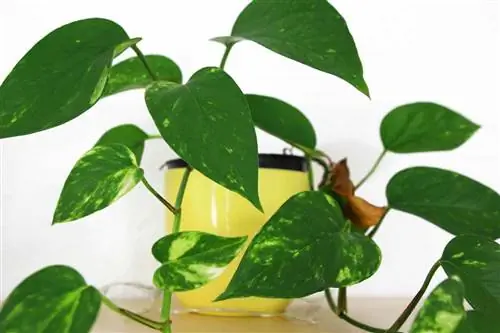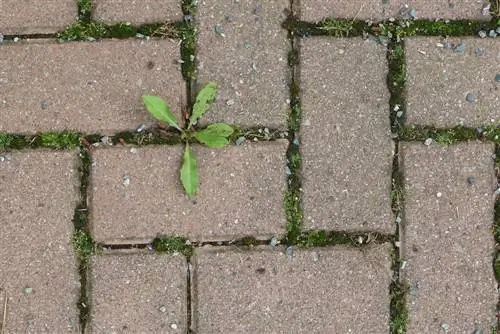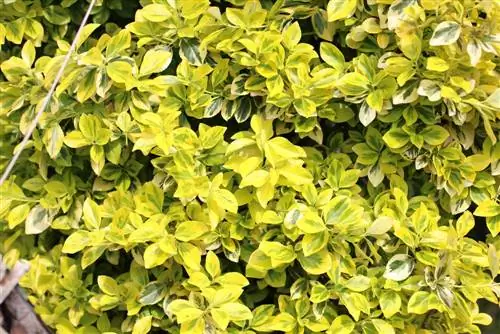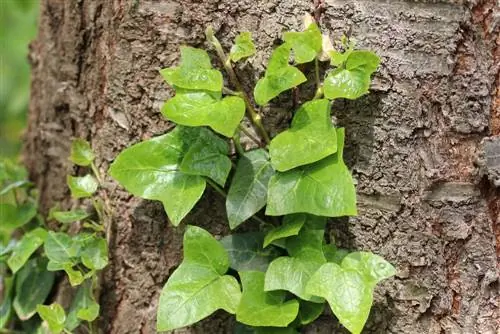- Author admin [email protected].
- Public 2023-12-17 03:39.
- Last modified 2025-01-24 12:45.
The culture of the ivy is comparatively simple. However, a few points must be taken into account when it comes to location, substrate, fertilizer and climbing aid. The following guide will help.
Location
Only a few points are important about the location. These include:
- bright
- no direct sun
- as high humidity as possible
- Avoid strong temperature fluctuations
- Temperature 18 to 22 °C
- protect from drafts
Especially in summer, care should be taken to ensure that there is neither blazing sun nor constant dryness. A spot by a window facing east or west, for example in the bathroom, is ideal. However, if the plant is in the living room or another rather dry room, you can also spray it with soft water or use a humidifier.
Tip:
If the leaves turn almost completely green and there is no white-green pattern, the plant is too dark. To compensate for this, more chlorophyll is formed.
Substrate
When it comes to soil, Epipremnum aureum is extremely easy to care for. The only requirements that must be met are the following criteria:
- permeable
- humos
- lime compatible
High-quality universal soil is sufficient. To increase permeability, sand or coconut fiber can be added.
Hydroculture
An alternative to classic substrate is hydroponics. Expanded clay, for example, can be used for this. However, you must keep in mind that once specimens have been grown in the ground, they are difficult to re-acclimate. It is therefore best if you choose hydroponics directly or grow your cuttings in expanded clay.
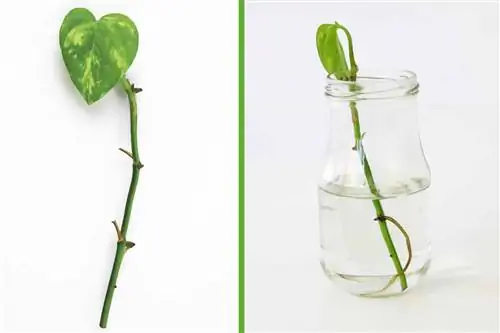
In the aquarium
Offshoots and cuttings of the ivy plant do not always have to be placed in substrate. Care and cultivation in water are also possible. The roots absorb nutrients and therefore have a cleansing effect.
However, you have to make sure that only the roots protrude into the water. Otherwise, rot may occur.
Pouring
Keeping it slightly moist throughout is best for the plant. It cannot tolerate waterlogging or prolonged dry periods. It should therefore be watered once a week from around February to October. During the winter, watering every two weeks is sufficient. The following variants are optimal:
- stale or filtered tap water
- collected rainwater
- low-lime, soft tap water
- Water from untreated aquariums or ponds
The advantage of these springs is that the irrigation water is soft and therefore only contains a small amount of lime. The roots can therefore absorb both liquid and nutrients better.
Tip:
If you are not sure whether your tap water has a high lime content, ask your local water authority. This information can often be easily found online.
Fertilize
Fertilizing is very easy. A liquid NPK fertilizer once a month from April to August is sufficient. Alternatively, you can use a slow-release fertilizer in spring when the first new shoots appear. Always remember that there must be sufficient watering after fertilization. Otherwise, chemical burns may occur on the roots.
Repotting
The soil in the planter should be replaced every two to three years. Because of the comparatively frequent watering, the substrate is used up relatively quickly. In addition, growth can be rapid. Root balls and tendrils then need a lot of space.
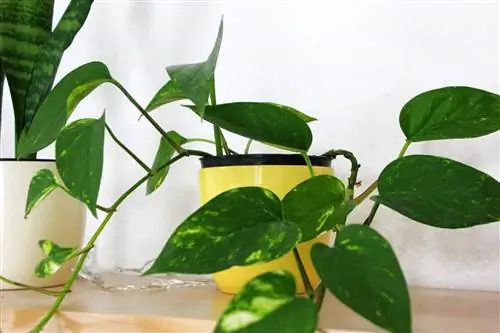
Repotting the ivy is easy. All you need to do is the following steps:
1. Remove soil thoroughly
Comprehensively removing the old substrate from the roots has a preventative effect. Both pathogens and any pests that may be present are removed. In addition, the absorption of nutrients is improved. Therefore, first remove the dry substrate and then wash off the root ball.
2. Cut off damaged parts
If you notice dead or damaged pieces on the roots, you must remove them. Give interfaces time to dry to reduce the risk of rot and mold.
3. Choose a planter
If the roots are already growing out of the holes in the flower pot, you should urgently choose a larger planter. A few centimeters more are enough. Otherwise, the root ball will become larger after repotting, but the remaining growth will be delayed.
4. Insert drainage
To prevent waterlogging, you should use a drainage layer. This is located at the bottom of the pot and can consist of coarse gravel or ceramic shards.
5. Insert plant
When filling the flower pot and planting the plant, make sure that the soil does not extend over the roots. Otherwise, rot could spread.
6. Pour on
After repotting the Epipremnum aureum, the substrate must be watered well. However, allow the soil to drain well before placing the planter in a planter or on a saucer.
Trail support
You have a large and comprehensive selection of climbing aids for the ivy plant. Possible examples are:
- Bamboo sticks
- Wire Meshes
- Grid made of wire or wood
- Moss sticks
By using a trellis, the shoots, some of which are very long, can be easily steered. Do you want a heart shape or a bow? Even spirals are possible.
Tip:
Attach the tendrils to the trellis with wire or plant clips until they have grown into the desired shape.
Blending and propagation
Propagate the ivy plant is very easy. For this purpose, shoots of the plant are simply cut off and placed in water, hydroponics or growing soil. Within a few weeks, roots develop, improving supply.
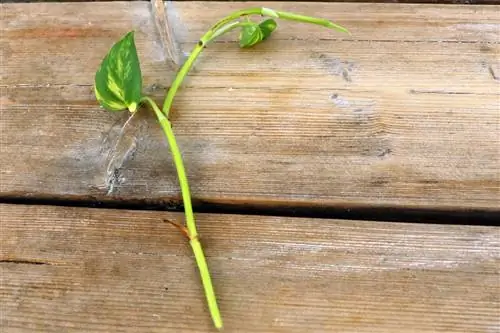
Wintering
Wintering is possible in two ways and is easy in either case. If possible, the plant can be overwintered at around 15 °C. The temperature should not be higher than 18 °C or lower than 10 °C. It is also important to reduce the amount of watering and stop fertilizing.
Another option is to overwinter the plant at normal room temperatures. A change in care does not then have to be made. However, it is necessary that the light supply be increased. Otherwise the plant will be too warm but not have enough brightness. A plant lamp can help here.
Pests
Spider mites represent a potential problem. Adapted and comprehensive care can prevent this parasite. This also applies to the following measures:
- Shower off the leaves
- Spray the plant with low-lime water
- regular checks for discoloration and other damage
Tip:
If you adapt your care accordingly, the risk of an infestation is extremely low. The ivy is also resilient and recovers quickly.

